
After the first "breaking seven" for the first time in the middle price of the RMB against the US dollar, the People's Bank of China announced on Monday (September 26) that two days later, the risk reserve of the long -term foreign exchange sales was increased significantly by 20 percentage points.This is the first time that the People's Bank of China has entered this counter -cyclical measure in the past two years, which is intended to raise the cost of short RMB and suppress the rapid depreciation of the RMB recently.
The scholars of the interviewed evaluated that the People's Bank of China does not care about the "Break Seven" (1 dollar against 7 yuan against RMB). The latest measures are mainly to curb speculation and prevent the financial market from continuing to continue to depreciate in the RMB and then crowded crazy. At the same time, at the same timeWhen currencies of many countries fell against the US dollar, they maintained the competitiveness of China's foreign trade exports.
The official website of the People's Bank of China issued an announcement on Monday, announcing that the foreign exchange risk reserve ratio of the long -term foreign exchange sales business has been adjusted from zero to 20 % since Wednesday (September 28), in order to stabilize the foreign exchange market expectations and strengthen macro macroManagement carefully.
On the day of the RMB to the US dollar exchange rate, it fell to 7.169 yuan on the day, a depreciation of the middle price of 1.98 %, but the US dollar index decreased after a high decline.
After the U.S. Federal Reserve raised interest rates, the US dollar index rose all the way. By the beginning of September, it hit a new high in 20 years, making China's raw materials, energy and food imports more expensive.The RMB at home and abroad has been depreciating rapidly since mid -late August, and both have fallen below the 7 yuan mark in mid -September. Since this year, the depreciation of the US dollar has exceeded 10 %.
The People's Bank of China has recently set up 23 consecutive trading days to set up the RMB to the US dollar in the middle of the US dollar significantly stronger than market expectations, but these derogatory signals have not effectively controlled the decline in the RMB.New measures opened on Wednesday are equivalent to increasing the cost of bank foreign exchange purchase by 20 %, which will deter the market.
Bloomberg quoted the analysis of Liu Peiqian, chief Chinese economist at the National West Min Group. The new measure means that the central bank intends to slow down the depreciation of the exchange rate, but it should not be unlikely to reverse the decline.
China consumed US $ 1 trillion (approximately S $ 1435 billion) foreign exchange reserve to support RMB when its economic recession in 2015, but then turned to more market tools to manage currencies.In August 2018, the central bank also launched a risk reserve for long -term foreign exchange purchase to respond to the pressure of the RMB during the Sino -US trade war, and canceled the measure after the RMB rapidly appreciated in October 2020.
Scholars: RMB "Break Seven" Central Bank of China actually enjoy it
Fu Fangjian, an associate professor of Li Guangqian Business School of Singapore Management University, analyzed in an interview with Lianhe Morning Post that the People's Bank of China was actually happy to see it for this RMB "breaking seven", because China's severe epidemic prevention caused domestic demand for tourism consumption.Economic development to a large extent rely on foreign trade, maintaining the low exchange rate can help enhance the competitiveness of Chinese products. "The exchange rate is lower, and the depreciation of the trend is not a bad thing."
But Fu Fangjian also pointed out that excessive depreciation may affect market confidence and trigger the financial crisis, and also cause imports to increase expensive production costs. When the central bank introduced measures, it must also "grasp a degree".
The 20th National Congress of the Communist Party of China was held in mid -October. Fu Fangjian also believed that the central bank's expected market expectations were also intended to maintain a stable exchange rate environment before the 20th National Congress.



